The deer had A Moveable Feast below the Green Hills of Alexander Valley. The more they fed on the vines, the more we wondered what crop we were going To Have and Have Not. Winemakers without grapes, like Men Without Women, become desperate. For the deer, it looked like it would become A Dangerous Summer in The Garden of Eden. Armed and experienced, my father knew For Whom the Bell Tolls. For the deer there might be Death in the Afternoon. But like the fisherman in The Old Man and the Sea, he chose to let the deer live. So he put up a tall fence. And In Our Time, the vineyards will be safe like Islands in the Stream.
This letter is not just for listing titles, but to update you on what is happening with the Scherrer Zinfandels. This year we have two Zinfandel futures offerings. Although we appreciate all the recipes for venison we received last year, we found an antidote (anti-doe?) for deer damage in the vineyard that does not involve violence. More on that later. The 1996 harvest had the lowest yields we have experienced since we began making our own wine from the vineyard in 1991. Our production was down 20% from 1995’s already low level. After several years’ experience making wines from different parts of the family vineyard and watching them develop separately and together in barrel, I think that the wines’ best interests will be served by keeping them as distinct bottlings in certain vintages. These are the same guidelines I use while making blending decisions at my daytime job at Dehlinger.
My favorite part of the oldest vineyard block (the ‘Old’ part, planted in 1912) makes a very intense, brooding, concentrated base component for our wine each year. It usually does best with a high proportion of whole clusters in the fermenter. Another part of the vineyard planted in 1978 (the ‘Mature’ part), makes a really racy, blackberry/raspberry wine with classical Zinfandel varietal character. These two areas, grown on mostly clay-like soil, complement and complete each other as the ‘Old and Mature Vines’ blend. We will have about 600 cases of this wine from 1996. I think this is the most focused and vibrant ‘Old and Mature’ blend we have had yet.
Another ‘mature’ area planted in 1975 produces a very soft but lively wine with an interesting cherry/strawberry-rhubarb pie character with a hint of black pepper. The wine is shaped very much like a good Pinot noir, and responds very well to Burgundian cooperage. Grown behind the family barn primarily on shale subsoil, its growth habits and wine personality seem consistent year to year. Rather than call it the Barnyard bottling, I think we will call it the ‘Shale Terrace’ (after all these years, I’m beginning to learn about naming things.) We will have about 200 cases of this wine from 1996. In the past, it was difficult to wait for this last area to ripen fully because of deer damage. This spring, a deer fence was installed to frustrate those poor beasts’ efforts at summertime fruit thinning and shoot trimming. Although my father pinned his arm under a fallen tree (fortunately suffering only minor injuries) while clearing the path for this fence, we all agree that it is worth the trouble and expense. We will just have to buy New Zealand venison now.
Download the complete newsletter: Scherrer Spring Release Notice

